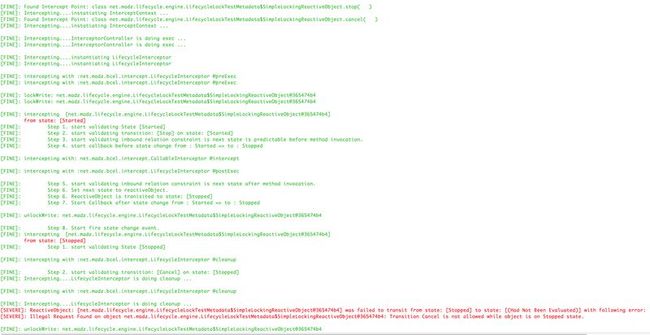@StateMachine
static interface LockingStateMachine {
@StateSet
static interface States {
@Initial
@Function(transition = LockingStateMachine.Transitions.Start.class, value = Started.class)
static interface Created {}
@Functions({ @Function(transition = LockingStateMachine.Transitions.Stop.class, value = Stopped.class),
@Function(transition = LockingStateMachine.Transitions.Cancel.class, value = Canceled.class) })
static interface Started {}
@End
static interface Stopped {}
@End
static interface Canceled {}
}
@TransitionSet
static interface Transitions {
static interface Start {}
static interface Stop {}
static interface Cancel {}
}
}
static interface ILockingReactiveObject {
public abstract int getCounter();
public abstract void start();
public abstract void stop();
public abstract void cancel();
}
public static class SimpleLock implements LifecycleLockStrategry {
private static Logger logger = Logger.getLogger("Lifecycle Framework");
private static volatile int depth = 0;
private final ReentrantReadWriteLock lock = new ReentrantReadWriteLock();
@Override
public void lockRead(Object reactiveObject) {
logLockingMethod(reactiveObject, "lockRead: ");
lock.readLock().lock();
depth++;
}
private void logLockingMethod(Object reactiveObject, String methodName) {
final StringBuilder builder = getIndent();
builder.append(methodName + reactiveObject);
logger.fine(builder.toString());
}
private StringBuilder getIndent() {
StringBuilder builder = new StringBuilder();
for ( int i = 0; i klass) throws Throwable {
final ExecutorService executorService = Executors.newFixedThreadPool(7);
for ( int i = 0; i c1 = new Callable() {
@Override
public LifecycleException call() throws Exception {
try {
object.stop();
return null;
} catch (LifecycleException e) {
return e;
}
}
};
Callable c2 = new Callable() {
@Override
public LifecycleException call() throws Exception {
try {
object.cancel();
return null;
} catch (LifecycleException e) {
return e;
}
}
};
if ( i % 2 == 0 ) {
Callable temp = c1;
c1 = c2;
c2 = temp;
}
final Future f1 = executorService.submit(c1);
final Future f2 = executorService.submit(c2);
final Callable c3 = new Callable() {
@Override
public Exception call() throws Exception {
try {
final LifecycleException e1 = f1.get();
final LifecycleException e2 = f2.get();
assertFalse(( null != e1 && null != e2 ) || ( null == e1 && null == e2 ));
final LifecycleException e = null != e1 ? e1 : e2;
System.out.println(e.toString());
assertEquals(LifecycleCommonErrors.ILLEGAL_TRANSITION_ON_STATE, e.getErrorCode());
assertEquals(2, object.getCounter());
return null;
} catch (Exception e) {
return e;
}
}
};
final Future f3 = executorService.submit(c3);
if ( null != f3.get() ) {
fail(f3.get().getMessage());
}
}
}
日志解释:
执行过程中的加(获取)写锁和解(释放)写锁的过程
[FINE]: Found Intercept Point: class net.madz.lifecycle.engine.LifecycleLockTestMetadata$SimpleLockingReactiveObject.start( )
[FINE]: Intercepting....instatiating InterceptContext ...
[FINE]: Intercepting....InterceptorController is doing exec ...
[FINE]: Intercepting....instantiating LifecycleInterceptor
[FINE]: intercepting with :net.madz.bcel.intercept.LifecycleInterceptor @preExec
[FINE]: lockWrite: net.madz.lifecycle.engine.LifecycleLockTestMetadata$SimpleLockingReactiveObject@62b9f149
[FINE]: intercepting [net.madz.lifecycle.engine.LifecycleLockTestMetadata$SimpleLockingReactiveObject@62b9f149]
from state: [Created]
[FINE]: Step 1. start validating State [Created]
[FINE]: Step 2. start validating transition: [Start] on state: [Created]
[FINE]: Step 3. start validating inbound relation constraint is next state is predictable before method invocation.
[FINE]: Step 4. start callback before state change from : Created => to : Started
[FINE]: intercepting with: net.madz.bcel.intercept.CallableInterceptor @intercept
[FINE]: intercepting with :net.madz.bcel.intercept.LifecycleInterceptor @postExec
[FINE]: Step 5. start validating inbound relation constraint is next state after method invocation.
[FINE]: Step 6. Set next state to reactiveObject.
[FINE]: Step 6. ReactiveObject is tranisited to state: [Started]
[FINE]: Step 7. Start Callback after state change from : Created => to : Started
[FINE]: unlockWrite: net.madz.lifecycle.engine.LifecycleLockTestMetadata$SimpleLockingReactiveObject@62b9f149
[FINE]: Step 8. Start fire state change event.
[FINE]: intercepting with :net.madz.bcel.intercept.LifecycleInterceptor @cleanup
[FINE]: Intercepting....LifecycleInterceptor is doing cleanup ...
并发执行同步过程日志
//线程一开始获取写锁
[FINE]: lockWrite: net.madz.lifecycle.engine.LifecycleLockTestMetadata$SimpleLockingReactiveObject@31c1fb39
//线程二开始获取写锁
[FINE]: lockWrite: net.madz.lifecycle.engine.LifecycleLockTestMetadata$SimpleLockingReactiveObject@31c1fb39
//线程一得到写锁并继续执行生命周期引擎
[FINE]: intercepting [net.madz.lifecycle.engine.LifecycleLockTestMetadata$SimpleLockingReactiveObject@31c1fb39]
from state: [Started]
[FINE]: Step 1. start validating State [Started]
[FINE]: Step 2. start validating transition: [Stop] on state: [Started]
[FINE]: Step 3. start validating inbound relation constraint is next state is predictable before method invocation.
[FINE]: Step 4. start callback before state change from : Started => to : Stopped
[FINE]: intercepting with: net.madz.bcel.intercept.CallableInterceptor @intercept
[FINE]: intercepting with :net.madz.bcel.intercept.LifecycleInterceptor @postExec
[FINE]: Step 5. start validating inbound relation constraint is next state after method invocation.
[FINE]: Step 6. Set next state to reactiveObject.
[FINE]: Step 6. ReactiveObject is tranisited to state: [Stopped]
[FINE]: Step 7. Start Callback after state change from : Started => to : Stopped
//第一线程执行完Transition开始解写锁
[FINE]: unlockWrite: net.madz.lifecycle.engine.LifecycleLockTestMetadata$SimpleLockingReactiveObject@31c1fb39
[FINE]: Step 8. Start fire state change event.
//线程二得到写锁开始执行引擎
[FINE]: intercepting [net.madz.lifecycle.engine.LifecycleLockTestMetadata$SimpleLockingReactiveObject@31c1fb39]
from state: [Stopped] //此时状态已经变为Stopped,线程一导致的变化至此已被线程二看见
[FINE]: intercepting with :net.madz.bcel.intercept.LifecycleInterceptor @cleanup
[FINE]: Step 1. start validating State [Stopped]
[FINE]: Intercepting....LifecycleInterceptor is doing cleanup ...
[FINE]: Step 2. start validating transition: [Cancel] on state: [Stopped]
[FINE]: intercepting with :net.madz.bcel.intercept.LifecycleInterceptor @cleanup
[FINE]: Intercepting....LifecycleInterceptor is doing cleanup ...
[SEVERE]: ReactiveObject: [net.madz.lifecycle.engine.LifecycleLockTestMetadata$SimpleLockingReactiveObject@31c1fb39] was failed to transit from state: [Stopped] to state: [(Had Not Been Evaluated)] with following error:
//由于在执行过程中另一线程导致状态发生变化,而使得本线程的Transition不合法
[SEVERE]: Illegal Request Found on object net.madz.lifecycle.engine.LifecycleLockTestMetadata$SimpleLockingReactiveObject@31c1fb39: Transition Cancel is not allowed while object is on Stopped state.
//线程二Transition失败后开始释放写[FINE]: unlockWrite: net.madz.lifecycle.engine.LifecycleLockTestMetadata$SimpleLockingReactiveObject@31c1fb39
前文:生命周期组件框架:关系型状态机服务
